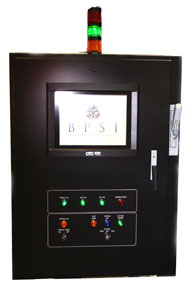
Building Protection Systems, Inc. (BPSI) has successfully produced
and tested the first to market system for monitoring, detecting
and containing airborne toxins and radiological/nuclear isotopes
in large commercial buildings. The Building Sentry One system brings
together proven technology with state-of-the-art application, in
a product with total install costs at a fraction of competing approaches
to building protection. "I'm extremely proud of the efforts
of our R&D and Integration teams. Their 100-plus years of aggregated
experience in this field have allowed us to develop and deliver
a system that will alter the Commercial Building landscape. In a
very short period of time we expect Building Sentry One, our flagship
product, to make premiere properties much safer for occupants, owners
and insurance underwriters." John Oliver, the company's Director
of Corporate Development said. Oliver went on to say, "This
is only the beginning. Once we get through our regional implementation,
we're eager to bring "Protected Building Status" to high-profile
buildings elsewhere.
|

BPSI
is the leading provider of building-based contaminant intrusion prevention
systems. The Building Sentry-One monitoring and containment system
is a breakthrough technology that makes prevention of building-targeted
terrorism a cost-effective reality. Our innovative approach offers
customer's unmatched prevention and containment at the local level,
with unrivaled economics, ultra-high performance, scalability and
reliability. BPSI is based in San Francisco, California. |
|
 |
SECURITY
RISK ARTICLES |
| |
Elliot
Blair Smith, USA TODAY
A $100 billion insurance safety net that makes up the losses
of American workers and businesses caused by a terror attack
is set to disappear at year's end amid growing concerns that
no replacement is in the offing.
Two examples: Chicago's O'Hare airport had $750 million in Terrorism
Insurance at an annual premium of $125,000 prior to the 9/11
attacks; afterward, it paid $6.9 million for $150 million in
coverage. San Francisco's Golden Gate Park was unable to obtain
any terrorism coverage after 9/11, and its non-terrorism coverage
was reduced by 80% to $25 million, for which its premium doubled
to $1.1 million. The Insurance Information Institute reported
last year that the insured losses from the 9/11 attacks approached
$32.5 billion. That was 30 times more costly to the insurance
industry than any prior terrorist attack and 1½ times
more expensive than the $21 billion cost of Hurricane Andrew
in 1992, the USA's most expensive natural disaster.
Andrew Coburn, Risk Management Solutions
Any attack using a chemical, biological or radiological agent
would cause huge property losses and lengthy business interruption
while buildings and streets were decontaminated effectively
quarantining a major area of a city for months or years.
>>More
Security Risk Articles |
|
|





